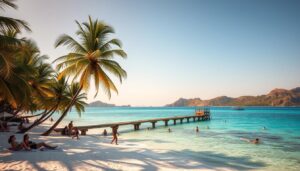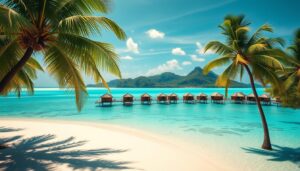Secret Islands You’ve Never Heard Of: Undiscovered Islands for Adventurous Travelers
1. Tetepare Island, Solomon Islands
Tetepare holds the distinction of being the largest uninhabited island in the South Pacific. This long, rugged island remains one of the world’s few truly undiscovered islands, covered with pristine lowland rainforest and surrounded by vibrant coral reefs teeming with marine life.

Location and Access: Located in the Western Province of the Solomon Islands, Tetepare can be reached by boat from Munda or Gizo. Local conservation rangers can arrange transportation, though visits must be planned well in advance due to the island’s protected status.
What Makes It Special: Tetepare was mysteriously abandoned by its original inhabitants nearly 200 years ago, and their descendants now manage the island as an ecological reserve. The island features untouched ecosystems, including some of the Solomon Islands’ last remaining lowland rainforest and nesting grounds for endangered leatherback turtles.
Highlights and Activities: Visitors can enjoy guided forest walks with local rangers, snorkeling among pristine reefs, wildlife spotting (including rare birds and marine turtles), and staying in simple eco-lodges managed by the Tetepare Descendants’ Association.
Best Time to Visit: May to November offers the most favorable weather conditions, with less rainfall and calmer seas for boat transfers. This period also coincides with leatherback turtle nesting season.
2. Aldabra Atoll, Seychelles
One of the most remote and untouched places on Earth, Aldabra is the world’s second-largest coral atoll. Its isolation has preserved its natural state, making it one of the most remarkable undiscovered islands for nature enthusiasts.

Location and Access: Located in the Outer Islands of Seychelles, approximately 1,100 kilometers from Mahé (the main island). Access is extremely limited, requiring special permits from the Seychelles Islands Foundation and typically arranged through scientific expeditions or specialized tour operators.
What Makes It Special: Aldabra hosts the world’s largest population of giant tortoises (over 150,000), untouched coral reefs, and unique wildlife that has evolved in isolation. UNESCO recognized its exceptional value by designating it a World Heritage Site.
Highlights and Activities: Observe giant tortoises in their natural habitat, snorkel in the pristine lagoon, spot rare birds like the Aldabra rail (the last flightless bird in the Indian Ocean), and witness unique marine life including manta rays and hammerhead sharks.
Best Time to Visit: April to May and October to November offer the calmest seas and best visibility for underwater exploration. These shoulder seasons avoid both the heavy rains and strongest winds.
3. Jaco Island, East Timor
Considered sacred by the local Timorese people, Jaco Island remains uninhabited yet accessible to respectful visitors. This small paradise sits at the easternmost point of East Timor, where the Banda and Timor seas meet.

Location and Access: Located off the eastern tip of East Timor, Jaco can be reached by hiring a local fishing boat from Tutuala Beach. The boat ride takes approximately 30 minutes across a narrow strait.
What Makes It Special: The island is considered sacred land by locals, which has protected it from development. Its location at the meeting point of two seas creates unique marine biodiversity and striking water color contrasts. As part of Nino Konis Santana National Park, it enjoys protected status.
Highlights and Activities: Enjoy pristine white sand beaches, swimming in crystal-clear waters, snorkeling among vibrant coral reefs, and day hikes around the small island. Camping is sometimes permitted with proper arrangements.
Best Time to Visit: May to November during the dry season offers the most pleasant conditions and calmer seas for the boat crossing.
While local fishermen can take you to the island for day trips, remember to respect the sacred nature of this land. Take nothing but photos and leave no trace of your visit.
Discover Sacred Jaco Island
Arrange a respectful visit to this pristine island with local guides who understand its cultural significance.
4. Antipodes Islands, New Zealand
With a name that literally means “opposite side of the world,” the Antipodes Islands are among the most isolated undiscovered islands on Earth. This volcanic archipelago sits in the subantarctic waters far from New Zealand’s mainland.

Location and Access: Located approximately 860 kilometers southeast of New Zealand’s South Island. Access is extremely restricted, with visits typically limited to scientific expeditions or specialized cruise ships that obtain special permits from the New Zealand Department of Conservation.
What Makes It Special: The Māori name for these islands is Moutere Mahue, meaning “abandoned islands.” Their extreme isolation has created unique ecosystems with endemic species found nowhere else. The islands are a UNESCO World Heritage Site as part of the New Zealand Subantarctic Islands.
Highlights and Activities: For the few who obtain permission to visit, the islands offer opportunities to observe unique wildlife including endemic parakeets, albatross colonies, and distinctive subantarctic vegetation. The dramatic volcanic landscapes feature steep cliffs and rugged terrain.
Best Time to Visit: The limited expeditions that visit typically do so during the southern hemisphere summer (December to February) when weather conditions are marginally better, though conditions remain challenging year-round.
5. Cocos Island, Costa Rica
Located far offshore in the Pacific Ocean, Cocos Island combines pirate legends with extraordinary natural beauty. This uninhabited island served as inspiration for the fictional Isla Nublar in Jurassic Park and remains one of the world’s premier diving destinations.

Location and Access: Situated approximately 550 kilometers off Costa Rica’s Pacific coast. The island can only be reached by liveaboard diving vessels, with journeys taking 30-36 hours from the mainland. All visits require permits from Costa Rican park authorities.
What Makes It Special: Cocos Island’s isolation has created a unique ecosystem both on land and underwater. The island is rumored to hide buried treasure from pirates of the 19th century, including the legendary Treasure of Lima. Its waters host extraordinary marine biodiversity, including large schools of hammerhead sharks.
Highlights and Activities: World-class scuba diving with opportunities to see hammerhead shark schools, whale sharks, manta rays, and other pelagic species. Limited hiking is permitted on the island with park rangers, allowing visitors to explore waterfalls and dense jungle landscapes.
Best Time to Visit: June to November offers the best conditions for diving, with increased chances of encountering large schools of hammerhead sharks. December to May typically has calmer seas but slightly reduced underwater visibility.
Dive the “Island of the Sharks”
Book a liveaboard diving expedition to experience one of the world’s most extraordinary marine ecosystems.
6. Socotra, Yemen
Often described as “the most alien-looking place on Earth,” Socotra is an isolated island with bizarre landscapes and unique flora that evolved in isolation for millions of years. Despite political challenges on the mainland, this undiscovered island remains a biological wonder.

Location and Access: Located in the Arabian Sea about 380 kilometers south of Yemen and 240 kilometers east of Somalia. Access has been challenging due to Yemen’s political situation, but limited flights from Cairo, Egypt or Abu Dhabi, UAE occasionally operate to the island.
What Makes It Special: Socotra’s isolation has created one of the world’s most unique ecosystems, with 37% of its plant species found nowhere else on Earth. The iconic Dragon’s Blood Tree with its umbrella shape and red sap is the most famous example. UNESCO recognized the island as a World Heritage Site for its exceptional biodiversity.
Highlights and Activities: Trek through otherworldly landscapes, photograph the unique Dragon’s Blood Trees and bottle-shaped Desert Roses, swim in natural pools, explore limestone caves, and visit traditional Socotri villages where ancient traditions continue.
Best Time to Visit: October to April offers the most pleasant weather, avoiding both the intense summer heat and the monsoon season that can make parts of the island inaccessible.
7. Palmyra Atoll, United States
A remote coral atoll in the Northern Pacific, Palmyra represents one of the last pristine marine wilderness areas on the planet. This undiscovered island is now a protected nature sanctuary with extremely limited access.

Location and Access: Located approximately 1,000 miles south of Hawaii in the Northern Pacific Ocean. Access is highly restricted, with permission required from both the U.S. Fish and Wildlife Service and The Nature Conservancy, who jointly manage the atoll.
What Makes It Special: Palmyra represents one of the most pristine tropical marine environments left on Earth. The atoll includes approximately 25 islets surrounding three lagoons. Its isolation and protected status have preserved extraordinary biodiversity both above and below the water.
Highlights and Activities: For the few researchers and volunteers permitted to visit, Palmyra offers opportunities to observe untouched coral reef ecosystems, large populations of nesting seabirds, and coconut forests. The surrounding waters host abundant marine life including sharks, manta rays, and numerous fish species.
Best Time to Visit: The limited visits that occur typically take place between June and November when weather conditions are most favorable, though the atoll experiences a tropical climate year-round.
8. Maldives Desert Islands
While the Maldives is known for luxury resorts, many of its 1,200 islands remain completely uninhabited and undeveloped. These undiscovered islands offer the quintessential desert island experience without the crowds.

Location and Access: Scattered throughout the Maldives archipelago in the Indian Ocean. Access to uninhabited islands can be arranged through local guesthouses on nearby inhabited islands or through specialized tour operators who organize day trips or overnight camping experiences.
What Makes It Special: While approximately 200 Maldivian islands are inhabited and another 90 have been developed as resorts, nearly 900 islands remain in their natural state. These range from tiny sandbanks to larger islands with lush vegetation, offering truly secluded experiences away from the luxury tourism the country is known for.
Highlights and Activities: Experience having an entire island to yourself, snorkel in untouched coral reefs, enjoy picnic lunches on pristine beaches, and for the adventurous, arrange overnight camping trips (with proper permits). Photography enthusiasts will find endless opportunities to capture perfect tropical island scenes.
Best Time to Visit: November to April offers the driest weather and best visibility for snorkeling and underwater activities. May to October can bring more rain but often features lower prices and fewer tourists.
Discover Your Private Maldivian Island
Arrange day trips or overnight camping experiences on uninhabited Maldivian islands.
9. Chacachacare Island, Trinidad and Tobago
Once a leper colony and now abandoned, Chacachacare Island combines fascinating history with natural beauty. This undiscovered island sits just off Trinidad’s northwest coast but feels worlds away from civilization.

Location and Access: Located in the Dragon’s Mouth strait between Trinidad and Venezuela. The island can be reached by private boat or water taxi from Trinidad’s Chaguaramas peninsula, with the journey taking approximately 45 minutes.
What Makes It Special: Chacachacare has a rich and somewhat haunting history. Originally named “Caracol” (snail) by Columbus for its shape, it later became a cotton plantation before being converted to a leprosarium in 1922. The island was abandoned in 1984 when the last patients were relocated, leaving behind haunting ruins that nature is slowly reclaiming.
Highlights and Activities: Explore abandoned structures including a nun’s quarters, doctor’s house, and patient facilities. Hike to the still-functioning lighthouse that offers panoramic views. Swim in secluded bays with crystal-clear water, and hike through forests now teeming with wildlife.
Best Time to Visit: January to May offers the driest weather and calmest seas for the boat journey. The island can be visited year-round, though heavy rains can make hiking challenging from June to December.
10. Ball’s Pyramid, Australia
Rising dramatically from the Pacific Ocean, Ball’s Pyramid is the tallest volcanic stack in the world. This razor-sharp spire harbors unique wildlife and presents one of the most visually striking undiscovered islands on the planet.

Location and Access: Located approximately 20 kilometers southeast of Lord Howe Island in the Tasman Sea. The pyramid can be viewed on boat tours operating from Lord Howe Island, though landing on the pyramid itself is highly restricted and requires special permits.
What Makes It Special: Ball’s Pyramid is a remnant of a shield volcano that formed about 7 million years ago. Rising 562 meters (1,844 feet) from the ocean, its dramatic spire shape makes it one of the most visually striking geological formations on Earth. The pyramid is also home to the Lord Howe Island stick insect, once thought extinct and rediscovered here in 2001 – now considered one of the rarest insects in the world.
Highlights and Activities: While landing is restricted, boat tours around the pyramid offer spectacular photography opportunities. For experienced climbers with special permits, the pyramid presents one of the world’s most challenging and unique climbing experiences, though climbing permissions are rarely granted.
Best Time to Visit: September to May offers the best weather conditions for boat tours around the pyramid, with calmer seas and better visibility. Lord Howe Island, the gateway to Ball’s Pyramid, limits visitors to 400 at any time, so advance planning is essential.
Embark on Your Own Undiscovered Island Adventure
These ten undiscovered islands represent just a fraction of the world’s hidden gems waiting to be explored by adventurous travelers. From the biological wonders of Socotra to the pristine marine environments of Tetepare, each offers a glimpse into what travel used to be – authentic, uncrowded, and filled with genuine discovery.
While reaching these remote destinations often requires extra effort, the rewards are immeasurable: pristine ecosystems, unique wildlife encounters, and the satisfaction of experiencing places that few others have seen. As you plan your journey to these secret tropical escapes, remember that their unspoiled nature is precisely what makes them special.

Ready to Discover Your Perfect Secret Island?
Remember that many of these undiscovered islands remain pristine precisely because they limit visitors and enforce conservation measures. Always travel responsibly, respect local regulations, and leave no trace of your visit. The greatest gift we can give future travelers is ensuring these secret islands remain as magical as we found them.

Eduard Kingly is a travel and lifestyle content creator with a focus on personal development and education. He combines firsthand travel experiences with research-driven insights to guide readers in discovering new places, building better habits, and pursuing meaningful learning.




